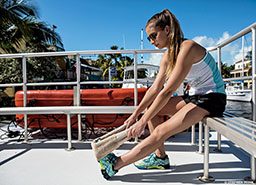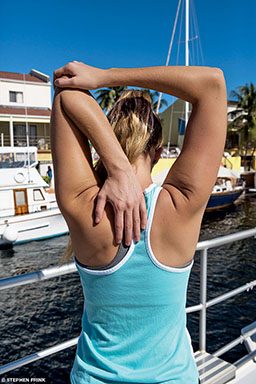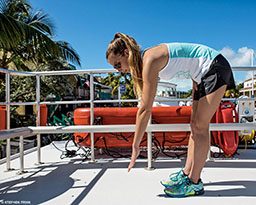Divers tend to be very invested in their gear. They clean masks, adjust straps, check computers, test regulators and shuffle weights prior to taking giant strides into the underwater realm. It is important that divers also remember to prepare their most important dive gear: their bodies.
Before you dive, take a moment to inventory your body. If you were sedentary on the ride out to the dive site your heart rate is probably near resting, so it is not circulating much oxygen to your muscles. Your muscles may be tight, which limits mobility. Your joints might be creaky, limiting comfort of movement. If you dive right in, you risk cramping up or starting the dive feeling less than optimal. You have invested a lot in your training, planning and preparation, so take a few minutes to prepare your body.
Diving is a physical activity. A proper warm-up and stretching routine is important for both enjoyment and safety during dives. A smart stretching session can boost circulation, lubricate joints and warm up muscles. It will allow you to don your gear and enter and exit the water with greater ease. It may also allow you to acclimate to the underwater environment more quickly.
A progressive warm-up gradually increases the heart rate and dilates the blood vessels, which promotes oxygenation of muscle tissue. Elevated muscle temperature optimizes efficiency and flexibility. A predive stretch reduces stress on muscles, tendons and joints and increases range of motion.
Before you dive, spend five to 10 minutes to complete a few rounds of the exercises below. Pay attention to how your body feels, and focus on any areas that seem tight.
Calf Stretch

Calf cramps are a common annoyance in diving; the calf muscles (gastrocnemius and soleus) are primarily responsible for pointing your toes during finning. Tight calf muscles can lead to cramping, so stretch your calf muscles before you dive.
If you are already wearing fins, stretch your calves just like you learned in your open-water class:
- Straighten your leg.
- Grab the blade of your fin.
- Pull the blade back toward your knee until you feel the stretch, and hold this position for 30-60 seconds.
- Repeat on the opposite side.
If you are not wearing fins:
- Sit with one leg straight (flat on the ground or seated on a bench).
- Loop a towel under your toes.
- Pull until you feel the stretch, and hold this position for 30-60 seconds.
- Repeat on the opposite side.

Back Scratcher Shoulder Stretch
You don’t want the first time you reach overhead to be when you need to reach a valve or locate your regulator.
- Extend one arm straight overhead.
- Bend your elbow, and reach down your spine.
- Grasp the bent elbow with the opposing hand.
- Gently pull your elbow, and hold this position for 30-60 seconds.
- Repeat on the opposite side.
Tip: Keep your head up.
Hanging Arm Circles

Rotator-cuff issues are a common ailment as we age. Activation of the rotator muscles prepares the shoulder for action and increases joint mobility.
- Bend over at your waist while maintaining a flat back.
- Let one arm hang freely, and rotate it 30 times clockwise and 30 times counterclockwise, gradually increasing the size of your circles.
- Use the other hand to brace yourself, if necessary.
- Switch arms after two to four sets.
Standing or Seated Trunk Twists

Lower-back tightness is a common cause of back problems, so warm up prior to donning heavy dive gear.
- Begin with a tall spine while either standing or sitting.
- Cross your arms in front of you like a genie.
- Slowly rotate to your right, hold this position for a two count, and return to center.
- Repeat to the left.
- Move smoothly, and maintain control.
Wall Push-Ups
Push-ups are excellent for activating the major muscles of the upper body.
- Stand facing a wall or a solid object at chest height.
- Extend your hands straight toward the wall with your palms flat and fingers facing up.
- Lower your chest toward the wall, hold this position for a two count, and slowly push away.
- Perform 10-15 repetitions.
Squats

Squats activate all the major muscles and joints of the lower body including the ankles, knees and hips.
- Begin with your feet slightly wider than shoulder width.
- Push your hips back while maintaining a flat back.
- Lower your hips as if sitting down, and keep your knees from traveling forward of your toes.
- Once you reach a comfortable seated position, stand up, pushing your hips forward.
Tip: Keep your heels on the floor at all times.
Note: Do squats only in calm seas.
NOTE: To avoid an increased risk of decompression sickness, DAN® recommends that divers avoid strenuous exercise for 24 hours after making a dive. During your annual physical exam or following any changes in your health status, consult your physician to ensure you have medical clearance to dive.
© Alert Diver — Q1 Winter 2016